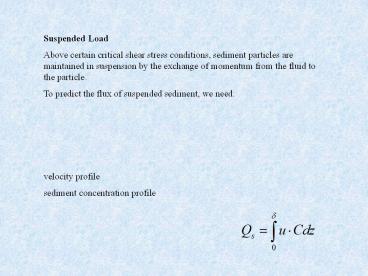Suspended Load - PowerPoint PPT Presentation
Title:
Suspended Load
Description:
Threshold for suspension: Suspension occurs under high shear ... Zone 4: Shear stress not sufficient to resuspend or maintain in suspension any suspended load. ... – PowerPoint PPT presentation
Number of Views:1441
Avg rating:3.0/5.0
Title: Suspended Load
1
Suspended Load Above certain critical shear
stress conditions, sediment particles are
maintained in suspension by the exchange of
momentum from the fluid to the particle. To
predict the flux of suspended sediment, we
need velocity profile sediment concentration
profile
2
Threshold for suspension Suspension occurs under
high shear stress flows, when turbulent
fluctuations in the vertical velocity of the flow
(w) are as strong, or stronger than the settling
velocity of sediment (Ws). The vertical
velocity fluctuations scale with the mean
velocity and thus the friction velocity of the
flow w? (0.8 to 1.0) x u, so the criteria for
incipient suspension is Ws ? u. Rouse Parameter,
P, defines the ratio of settling velocity to
vertical fluctuations
3
no suspension, stream weak - bedload incipient
suspension full suspension, stream strong -
suspended load
When compared to the threshold of motion
criteria, it is seen that, for fine-grained
sediment (D lt 63 - 88 ?m) the suspension
threshold is less restrictive than that for the
transport threshold. Silts Clays will be
suspended as soon as they become mobile, and will
not tend to be transported as bedload. Some flows
have transport capacity, but can not resuspend.
4
(No Transcript)
5
Zone 1 Shear stress sufficient to erode the
bed. Shear stress sufficient for significant
suspended load transport. Zone 2 Shear stress
not sufficient for erosion. Shear stress
sufficient for suspended load maintenance. Zone
3 Shear stress not sufficient for
erosion. Transport along bottom maintained as
bedload. Material placed in suspension at higher
shear stress levels could move into the bedload
layer. Zone 4 Shear stress not sufficient to
resuspend or maintain in suspension any suspended
load.
6
Conservation of Mass for Suspended Sediment
Full equation Where us, vs, ws are the
components of sediment velocity Assume steady
state uniform flow in horizontal Next
remember that the flow is turbulent, and we can
treat the mean and fluctuating components
separately.
7
Conservation of suspended sediment for steady,
uniform flow becomes
Time-averaging
8
Vertical sediment velocity Ws
(time-averaged) and can be pulled out of the
differential Eddy Diffusivity for Mass We
can use the same gradient diffusion argument as
we did for the mixing of momentum In analogy,
for sediment
9
Integrating ..
Need a form for the eddy diffusivity for mass (Ks)
10
Solve for the concentration profile where
P is the Rouse parameter (P Ws/?u ) and za is
the reference height where concentration, ca, can
be specified.
11
Notes For a grain-size distribution of sediment,
calculate profile for each size, then add
together. To get profiles that are valid
throughout a thicker region of the bottom
boundary layer, different values of the eddy
diffusivity must be used. At high
concentrations, conservation of mass should be
rewritten to take both water mass and sediment
mass into account.
12
- Rouse Parameter
- if P is high
- if P is low
- Where do we position a
- top of bedload layer 2D
- practically - 1-2 cm above bed
z
C
z
C
13
Holding the grain size constant very fine sand,
D 0.1 mm ca 1 at a 2 cm at higher u,
more sediment in water column at lower u,
turbulent diffusion cant support sediment grains
14
Holding the shear velocity constant u 2
cm/s ca 1 at a 2 cm finer grain sizes
distributed throughout bottom boundary
layer coarser sizes suspended only very near bed.
15
We still need to know the concentration at a
reference elevation (ca) to compute the
concentration profile. Reference height can be a
location at which you have some idea of
concentration from data or from theory. Yalin -
proposed that, near the bed at steady state,
concentrations should increase with excess shear
stress, cs is proportional to S Smith
McLean - proposed that za be taken at the top of
the bedload layer (which they related to zo) and
formed the relationship
16
Where cb is the concentration of the bed ca is
taken at zo ?o is the resuspension parameter,
in sands 2.4 x 10-3 (Smith McLean) experimental
values have been shown to range 1.6 x
10-5 5.4 x 10-3































